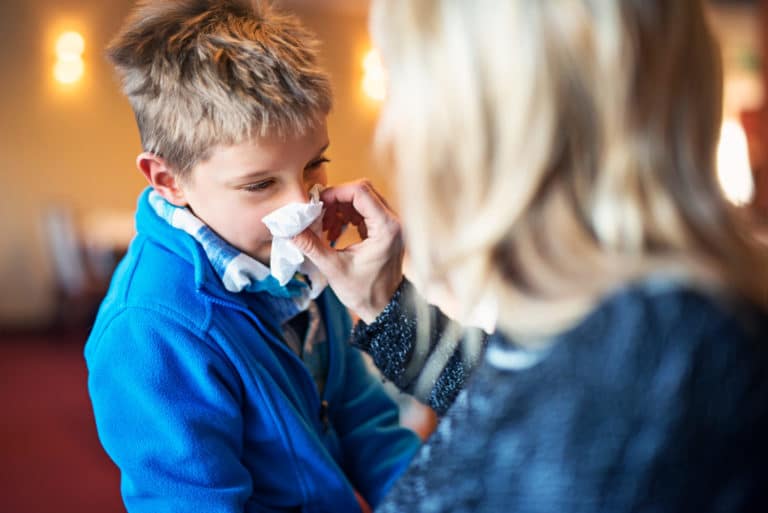Sinus Anatomy:
The maxillary (behind the cheek) and ethmoid (honeycomb air cells between the eyes) sinuses are present at birth. The frontal and sphenoid (in the very back of the nose) sinuses develop later. The sinuses are not fully developed until age 20.

Sinusitis is a general word that means inflammation of the sinuses.
Children can get sinus infections. Because of their immature immune system, children are more susceptible to viral upper respiratory infections; approximately 6-8 colds per year. The sinuses drain through small narrow openings into the nose. The mucosal lining has thousands of tiny hair cells called cilia which sweep the mucus through the small openings into the nose. During a viral infection, swelling and inflammation can block off the openings. Viral infections also cause the cilia to not work well. Mucus becomes trapped and can become infected by bacteria.
Sinusitis: Overview
Enlarged or chronically infected adenoids (tonsil like tissue in the back of the nose) can cause:
- Nasal obstruction, snoring
- Frequent nasal drainage
- Frequent nose / sinus infections
- Frequent ear infections
The following symptoms may indicate a sinus infection in your child:
- A cold lasting more than 10 to 14 days, sometimes with low-grade fever
- Thick yellow-green nasal drainage
- Post-nasal drip, sometimes leading to or exhibited as sore throat, cough, bad breath, nausea and/or vomiting
- Irritability or fatigue
- Swelling around the eyes
- If these symptoms persist despite appropriate medical therapy, care should be taken to seek an underlying cause. The role of allergy and frequent upper respiratory infections should be considered.
Allergies: Introduction
Does your child have allergies?
Allergies can cause many ear, nose, and throat symptoms in children, but allergies can be difficult to separate out from other causes. There often is a strong family history of allergy problems.
Children with nasal allergies often have other allergic tendencies (or atopy).
- Early food allergy or sensitivity
- Atopic dermatitis in infancy
- Children with nasal allergies are at higher risk for developing asthma
Nasal Allergy Signs and Symptoms:
- Itching
- Sneezing
- Nasal congestion
- Nasal drainage
- Nasal rubbing – “allergic salute”
- Itchy, watery eyes
- Dark circles under eyes – “allergic shiner”
- Frequent throat clearing
- Cough at night when lying flat
- Poor sleep and daytime fatigue
Allergy Related Ear, Nose and Throat Problems Include:
- Ear infections
- Sore throat from “post-nasal drip”
- Cough from “post-nasal drip”
- Chronic nasal obstruction
- Snoring, sleep apnea
- Sinus infections
- Enlarged adenoids (tonsil-like tissue in the back of the nose)
Pediatric Sinus and Allergy Evaluation and Treatment:
- Complete history and physical examination to obtain accurate diagnosis
- Diagnostic testing if indicated
- Treatment directed to specific problem
Call Mt. Hood ENT & Allergy at (503) 257-3204 for more information or to schedule an appointment.
References:
American Academy of Otolaryngology−Head and Neck Surgery. One Prince St., Alexandria, VA 22314-3357, 1-703-836-4444. 2010 AAO-HNS/AAO-HNSF Flint, P. W., C. W. Cummings, et al. (2010). Cummings otolaryngology head & neck surgery. Philadelphia, PA, Mosby/Elsevier: 3 v. (xlii, 2963, cxciv p.).